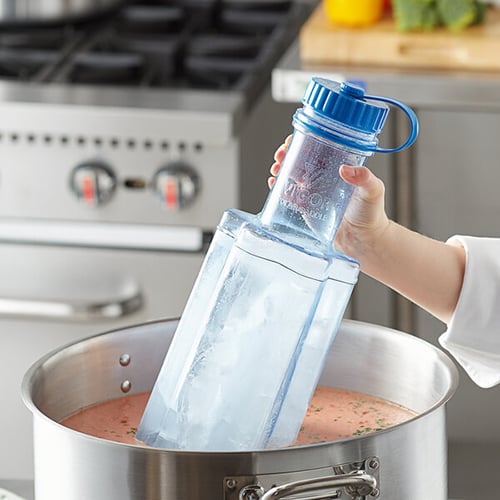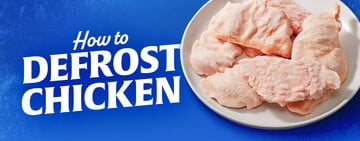
The top priority in a commercial kitchen is understanding and enforcing food safety temperatures. Neglecting them can put customers at serious risk of contracting foodborne illnesses. To ensure food safety, foodservice operators and handlers must understand the temperature danger zone and its impacts. We'll explain the danger zone temperature range, which foods are most at risk, and how to prevent food from lingering at hazardous temperatures.
Shop All Kitchen ThermometersWhat Is the Danger Zone for Food?
The danger zone refers to the temperature range that accelerates bacteria growth in food. According to ServSafe recommendations (an authority on foodservice training material), food temperatures between 41 and 135 degrees Fahrenheit represent this danger zone (5 and 57 degrees Celsius). Bacteria thrive and multiply most rapidly between temperatures of 70 and 125 degrees Fahrenheit. The longer food sits in the temperature danger zone, the greater the risk that bacteria will grow.

Why Is the Temperature Danger Zone Important?
When foods are allowed to enter the temperature danger zone, bacteria may grow to unhealthy levels and cause the food to spoil. Dangerous bacteria growth like this may occur without any visible signs that the food is unsafe for consumption. Foods may smell and appear normal but could contain harmful amounts of bacteria that will cause foodborne illness.
This is what makes the temp danger zone extremely important. As a food service professional, it’s your responsibility to keep foods out of the danger zone by using approved methods to chill, heat, and store foods.
What Is Time Temperature Abuse?
Time temperature abuse is the act of allowing foods to stay in the temperature danger zone of 41 to 135 degrees Fahrenheit. Along with cross-contamination, time temperature abuse is a common source of foodborne illness, making it a major health code violation. Foods may become time-temperature abused in three ways:
- Foods are not held or stored at food safe temperatures
- Food is not cooked or reheated to the temperature required to eliminate possible pathogens
- Hot food is not cooled properly before being placed in cold storage
What Are TCS Foods?

TCS stands for time/temperature control safety. Foods that require strict time and temperature control are considered TCS foods. Pathogens love TCS foods because they present an ideal environment for germs to grow and spread. Preventing TCS foods from entering the danger zone and becoming time-temperature abused is a critical food safety practice. These are the high-risk TCS foods that should be closely monitored at all times:
- Milk and dairy products
- Meat and poultry
- Fish, shellfish, and crustaceans
- Shell eggs
- Baked potatoes
- Cooked rice, beans, and vegetables
- Tofu, soy protein, or other plant-based meat alternatives
- Sprouts and sprout seeds
- Cut tomatoes, melons, and leafy greens
- Untreated garlic and oil mixtures
How Long Can Food Stay in the Temperature Danger Zone?
ServSafe states that 4 hours is the maximum length of time ready-to-eat foods can stay in the temperature danger zone. After the 4-hour limit, foods are considered spoiled and must be thrown away. Within the 4-hour time limit, foods can be consumed, reheated, or chilled to bring them back to food safe temperatures. Checking temps every 2 hours allows for a greater window to perform any necessary corrective actions.
How to Keep Food Out of the Danger Zone
Kitchen thermometers are the key to keeping foods out of the temp danger zone. By monitoring and recording food temperatures regularly, you can prevent foods from becoming time-temperature abused. This is imperative while prepping, cooking, and holding food on your buffet line or salad bar.
Follow these important tips to ensure you’re making the best use of your kitchen thermometers to keep food safe for consumption.
- Always use the right type of thermometer for the job.
- Never rely on the temperature display of your equipment alone.
- Place a thermometer inside your refrigerator or freezer as an additional safety measure.
- Keep written records of all temperature checks that include the temp, the time, and the name of the operator.
- Clean and calibrate thermometers often.
As part of your HACCP training, be sure that your staff members know how to perform these temperature logging procedures to keep your menu items out of the danger zone.
Use our downloadable Food Holding Temperature Log!
Download our Food Holding Temperature Log PDF
Food Holding Temperature

Once your food is cooked to the proper internal temperature or chilled to 40 degrees Fahrenheit or below, it’s important to maintain these safe temperatures before serving. There are several instances in which foodservice professionals need to hold food for extended periods. These instances could include holding food in salad bars and buffet lines or transporting food to off-site locations and catering events.
When transporting food, it is recommended you use a food pan carrier or insulated catering bag to ensure your hot or cold foods remain safe for consumption.
Cold Holding Temperature
The cold food holding temperature for TCS foods must be 40 degrees Fahrenheit or below. Here are some tips to properly hold cold foods so they don't fall into the danger zone:
- Ensure your cold-holding equipment, like cold food tables and cold crocks, keeps foods at 40 degrees Fahrenheit and below.
- Any cold food held without refrigeration is safe for up to 6 hours, starting from the time it was removed from refrigeration at 40 degrees Fahrenheit and below.
- Check the temperature of cold foods every 2 hours and discard any cold food that reaches a temperature of 70 degrees Fahrenheit or higher.
How Cold Does a Salad Bar or Refrigerator Have to Be to Keep Food Safe?
Salad bars and refrigerators need to maintain temperatures at 40 degrees Fahrenheit and below to prevent the growth of dangerous bacteria. This is especially important as you house vulnerable TCS foods including cheese, yogurts, meats, salad dressings, and egg products.
Hot Holding Temperature
The appropriate holding temperature for hot food is 135 degrees Fahrenheit or above. Here are some tips to keep hot foods out of the danger zone:
- Never use hot holding equipment to reheat food. Foods should be heated to safe temperatures prior to holding. Hot holding equipment, like steam tables and holding cabinets, is designed to maintain current temps, not bring food up to temp.
- When possible, keep food covered to help maintain temperatures and keep contaminants out.
- Stir frequently to distribute heat throughout the food.
- Use the appropriate thermometer to monitor food temperatures often.
- Discard hot food that has been sitting below 135 degrees Fahrenheit for more than 4 hours.
- Never mix freshly prepared food with foods already being held for service to prevent cross-contamination.
How Often Should I Check the Temperature of Hot or Cold Holding Food?
It is recommended you check the temperature of your hot or cold holding food every four hours. However, if you check every 2 hours instead, this allows enough time to take corrective action if food has fallen into the danger zone. By staying on top of your food’s internal temperatures, you can prevent the spread of dangerous bacteria and eliminate food waste by simply re-heating or re-chilling the affected foods before bacteria has time to spread.
Danger Zone FAQs
Here are some of the most common questions about the danger zone that you may encounter in your kitchen:
Proper Cooling of Foods

If you're preparing food ahead of time and placing it into cold storage for holding, it has to be properly cooled first. Once your menu item has reached its proper internal temperature, it is essential to quickly bring the temperature down through the danger zone. Cool your food to 70 degrees Fahrenheit within 2 hours and then further down to 41 degrees Fahrenheit within 4 hours.
Though it seems like the simplest option, placing hot food directly into your refrigerator or freezer is never recommended because it endangers the food around it by raising the ambient temperature in your fridge or freezer. This creates the possibility of other foods in your refrigerator or freezer entering the temperature danger zone and developing bacteria without you even knowing. Instead, follow these tips for quickly cooling your hot foods.
- Use a commercial blast chiller to cool foods quickly and minimize the time food spends in the danger zone.
- Store foods in shallow containers to allow the temperature to distribute more evenly.
- Consider using a cooling paddle to reduce the temperature of hot liquids including soups, stews, and sauces.
- Create an ice bath by filling a pot, container, or sink basin with ice. Containers of hot foods can be placed in the ice bath to quickly cool food to 40 degrees Fahrenheit or below.
How to Thaw Food
One of the most common examples of time temperature abuse in a kitchen is defrosting food incorrectly. It can be tempting to leave food out on the counter to thaw or run it under hot water, but these put your foods at risk of entering the danger zone. Use the following methods to defrost food safely:
- Move the frozen food to the refrigerator 10-24 hours before cooking.
- Place the frozen food under cold running water in a clean prep sink.
- Use the defrost setting on a microwave.
- Cook from frozen, regularly checking internal temperatures.
Safe Cooking Temperatures
Along with concerns for the danger zone, you'll also want to make sure your foods have reached safe internal temperatures for at least 15 seconds before they can be served. Below is a temperature guide for some of the most common ingredients.
- Cook to 165 degrees Fahrenheit: Poultry, stuffing, any dish that contains a cooked TCS food
- Cook to 155 degrees Fahrenheit: Ground meat, flavor-injected meats, eggs from the shell
- Cook to 145 degrees Fahrenheit: Seafood, steaks and chops, game meat, roast meats
- Cook to 135 degrees Fahrenheit: Fruits, vegetables, grains, legumes
Back to Top
It's every food service operator's top priority to keep the food they're serving safe for consumption. Following these important tips and getting your staff food handling certified will ensure that they have the knowledge to keep food out of the danger zone, take corrective action, and protect customers from foodborne illnesses.





